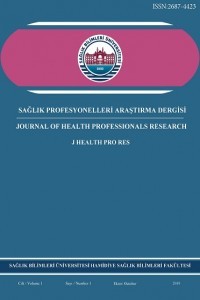Üniversite Öğrencilerinin Diyet Posa Alımı ve Dışkılama Sıklığı
Diyet posası, Dışkılama, Konstipasyon, Üniversite öğrencisi
Dietary Fiber Intake and Defection Frequency of University Students
Dietary fiber, Defecation, Constipation, University student,
___
- Stephen A., Champ M., Cloran S., Fleith M., Lieshout L., Mejborn H., Burley V. ‘‘Dietary fibre in Europe: current state of knowledge on definitions, sources, recommendations, intakes and relationships to health’’, Nutrition Research Reviews, 2017;30:149-190.
- Ergene E., Bingöl E., ‘Diyet Lif İçeriği Yüksek Bazı Gıdalar ve Beslenme Üzerindeki Etkileri’, Adnan Menderes Üniversitesi Sağlık Bilimleri Fakültesi Dergisi 2019;3(1):70-78.
- Arslan, S., Erbaş M., ‘Selüloz ve Selüloz Türevi Diyet Liflerin Özellikleri ve Fırın Ürünlerinde Kullanım İmkanları’ Gıda, 2014;39(4):243-25
- Turksoy S, Özkaya H, Duman B, ‘‘Effect of Dephytinization by Fermentation and Hydrothermal Autoclaving Treatments on the Antioxidant Activity, Dietary Fiber, and Phenolic Content of Oat Bran.’’, Journal of Agricultural And Food Chemistry, 2017;65(28):5713-5719.
- Dülger D, Şahan Y. ‘‘Diyet lifin özellikleri ve sağlık üzerindeki etkileri’’, Journal of Agricultural Faculty of Uludag Unıversty, 2011;25(2):147-157.
- Ötles S., Ozgoz S., ‘‘Health effects of dietary fiber’’, Acta Sci. Pol., Technol. Aliment. 2014;13(2):191-202
- Makki K., Deehan E., Walter J., Backhed F., ‘‘The İmpact of Dietary Fiber on Gut Microbiota in Host Health and Disease’’, Cell Host & Microme, 2018;23(6):705-715.
- Forootan, M.; Bagheri, N.; Darvishi, M. Chronic constipation a review of literature. Medicine 2018; 97:20.
- Özcan B., Saka M., ‘‘Fonksiyonel konstipasyonu olan yetişkin bireylerin posa, sıvı ve vitamin mineral alımlarının değerlendirilmesi’’, Beslenme Diyet Dergisi, 2018; 46(3):220-229.
- 1Suares NC, Ford AC. Prevalence of, and risk factors for, chronic idiopathic constipation in the community: systematic review and metanalysis. Am J Gastroenterol 2011; 106:1582-1591.
- Türkiye Beslenme Rehberi, T.C. Sağlık Bakanlığı Türkiye Halk Sağlığı Kurumu, Ankara, 2016.
- World Health Organization (WHO). Physical Activity and Adults. 2019. Available from: https://www.who.int/dietphysicalactivity/factsheet_ adults/en/
- Kalkan İ., Pehlivan M., Öztürk S., Ersoy G., ‘‘İstanbul Aydın Üniversitesi Beslenme ve Diyetetik 1. Sınıf Öğrencilerinin Beslenme Alışkanlıkları ve Fiziksel Aktivite Düzeylerinin Saptanması’’, Aydın Sağlık Dergisi, 2018;4(1):45-60.
- Folden S. Practice guidelines for the management of constipation in adults. Rehabilitation Nursing Foundation, 2002;27(5):169-175.
- Akyol P., İmamoğlu O., ‘‘Üniversite öğrencilerinde cinsiyete göre beslenme alışkanlıkları’’, Spormetre, 2019;17(3):67-77.
- Türkiye Beslenme ve Sağlık Araştırması, T.C. Sağlık Bakanlığı Türkiye Halk Sağlığı Genel Müdürlüğü, Ankara, 2019.
- Xu, L.; Yu, W.; Jiang, J.; Li, N. Clinical benefits after soluble dietary fiber supplementation: A randomized clinical trial in adults with slow-transit constipation. Zhonghua Yi Xue Za Zhi 2014;94:3813-3816.
- De Schryver M, Keulemans C, Peters P. Effects of regular physical activity on defecation pattern in middle-aged patients complaining of chronic constipation. Scand J Gastroenterol 2005;40(4):422-429.
- Lin Y, Huybrechts I, Vereecken C, Mouratidou T, Valtuena J, Kersting M, et al. Dietary fiber intake and its association with indicators of adiposity and serum biomarkers in European adolescents: the HELENA study. Eur J Nutr. 2015;54(5):771-82.
- Holscher H., ‘‘Dietary fiber and prebiotics and the gastrointestinal microbiota’’, Gut microbes, 2017;8(2):172-184.
- Aliasgharzadeh A, Dehghan P, Gargari BP, Asghari-Jafarabadi M. Resistant dextrin, as a prebiotic, improves insulin resistance and inflammation in women with type 2 diabetes: a randomised controlled clinical trial. Br J Nutr. 2015;113(2):321-330.
- Azadbakht L, Haghighatdoost F, Esmaillzadeh A. White Rice Consumption, Body Mass Index, and Waist Circumference among Iranian Female Adolescents. J Am Coll Nutr. 2016;35(6):495-499.
- Suares NC, Ford AC. Prevalence of, and risk factors for, chronic idiopathic constipation in the community: systematic review and metanalysis. Am J Gastroenterol 2011; 106:1582-91.
- ISSN: 2687-4423
- Yayın Aralığı: Yılda 3 Sayı
- Başlangıç: 2019
- Yayıncı: Sağlık Bilimleri Üniversitesi
TÜRKİYE’DE PALYATİF BAKIM HİZMETLERİNİN ORGANİZASYONUNA YÖNELİK BİR DEĞERLENDİRME
Bronşektazide Pulmoner Rehabilitasyon
Üniversite Öğrencilerinin Diyet Posa Alımı ve Dışkılama Sıklığı
Ebelerin Profesyonel Değerleri ve Mesleki Yetkileriyle İlgili Algılarının Değerlendirmesi
Melek BALÇIK ÇOLAK, Sibel İÇKE
Betül AKALIN, Arzu İRBAN, Gizem ÖZARGUN
Hemşirelerin Kanıta Dayalı Uygulama Ölçeği’nin Türkçe Geçerlik ve Güvenirliği: Metodolojik Çalışma
Burcu ÇAKI, Şirin ÇELİKKANAT, Zeynep GÜNGÖRMÜŞ
MATERNAL - PATERNAL BAĞLANMAYI ETKİLEYEN FAKTÖRLER VE EBELİK YAKLAŞIMLARI
Engelli Çalışanların İş Sağlığı ve Güvenliği Eğitimlerinin İncelenmesi
Serhat SARI, Furkan BERBER, Sıtkı Buğra KÖSEOĞLU, Gamze Necmiye UYGUN, Serap TEPE
Palyatif Bakım Hastalarına Bakım Veren Sağlık Çalışanlarının Yaşadığı Sorunlar ve Çözüm Önerileri
